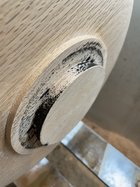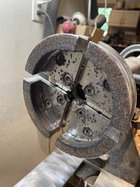Anyone ever experienced this on a wood lathe? I have a Laguna Revo 18/36 I bought new last year and noticed an occasional slight discoloration on the tenon. I didn’t think much of it until the other day I left a bowl in the lathe and found the mess shown in the below photos. This is definitely electrolysis. The lathe is sitting in rubber shop mats and not in direct contact with the floor. I’m thinking of running a ground wire from the frame but maybe just cut some holes in the matting and drop it onto the floor.
-
October 2025 Turning Challenge: Natural Edge Bowl! (click here for details) -
Congratulations to Curt Fuller for "Bell Ornaments" being selected as Turning of the Week for October 27, 2025 (click here for details) -
Welcome new registering member. Your username must be your real First and Last name (for example: John Doe). "Screen names" and "handles" are not allowed and your registration will be deleted if you don't use your real name. Also, do not use all caps nor all lower case.
You are using an out of date browser. It may not display this or other websites correctly.
You should upgrade or use an alternative browser.
You should upgrade or use an alternative browser.
Electrolysis?
- Thread starter Ernest Leep
- Start date
What is the wood and how wet was it? High tannin woods like oak will react with steel like that, especially if there is some moisture.
Wouldn't you need some electrical potential to drive electrolysis? I would assume the wood and chuck are on the same plane.
Wouldn't you need some electrical potential to drive electrolysis? I would assume the wood and chuck are on the same plane.
Agree with Jason. That bowl probably has more moisture than you think due to thickness, not enough drying time and/or when it’s at an high equilibrium moisture content (EMC) especially with all the rain lately. Also, the wood bowl looks like red oak so there’s tannins getting leached onto the metal and turning things black. Luckily chuck should sand out, and the bowl can be cleaned up when it’s reversed turned.
Tip: If the tannins in wood like red oak or chestnut stains your hands then use fresh lemon juice to clear up the stain.
Tip: If the tannins in wood like red oak or chestnut stains your hands then use fresh lemon juice to clear up the stain.
Just looked up where you live Jason. Definitely high humidity there so I wouldn’t leave any high tannin woods like red oak touching metal any longer than necessary for turning. The EMC in your area is probably between 13% and 18% at the moment so you might also want to consider running a dehumidifier in your shop.
As stated above, high tannin wood and humidity will cause this. Looks like some type of oak on your lathe. Don't leave green wood in the chuck overnight or rust can happen. Also if I'm turning oak I learned to spray the bedways with WD40 or a similar product before starting. Green walnut can do this also.
- Joined
- Apr 27, 2004
- Messages
- 9,292
- Likes
- 6,028
- Location
- Lakeland, Florida
- Website
- www.hockenberywoodturning.com
As above I think it is a black iron stain. Woods with tannins get them when in contact with iron.
Lemon juice will remove it.
Lemon juice will remove it.
Here is a good tutorial from Chris Ramsey for how to remove these stains:
Lemon juice works in a pinch, but if the stain is stubborn try Bar Keeper’s Friend. It’s an oxalic acid based product, and is a miracle when nothing else works.
Lemon juice works in a pinch, but if the stain is stubborn try Bar Keeper’s Friend. It’s an oxalic acid based product, and is a miracle when nothing else works.
That is 100% corrosion from the white oak piece on your lathe. As others mentioned, the tannic acids in oak (tannins) react quickly with iron. This is a good thing only if you are attempting to stain the oak, (off the lathe of course). Dry oak is typically not an issue, but green oak will cause corrosion on any of your cast iron surfaces in short order.
I keep a bottle of concentrated lemon juice for that in the shop at all times. When fresh, those stains will come out in seconds. If it has sat for a while, it may take a while to get them out. The lemon juice can bleach out dry woods.
robo hippy
robo hippy
Thanks all for the very helpful info! Yes it’s red oak and while not green it still has a lot of moisture and this time of year very humid. I’m just glad it isn’t electrolysis as that really had me scratching my head trying to figure out how an excellent insulator like wood would have potential. But I’m a retired Marine Engineer and have seen some pretty strange things happen. The chuck jaws cleaned right up no problem and the tenon I cut off anyway.
Thanks again guys!
Thanks again guys!
The company that I used to work for made a commercial product for the wood flooring manufactures for removing iron stain. As I recall it was about 95% Oxalic acid and 5% citric acid. The tip about Bar Keepers Friend is a good one as it would be a lot easier to find than Oxalic acid.
Here’s a very relevant thread about this issue. I had a White Oak bowl that was stained and I asked for advice. I learned a lot of things from this one;
 www.aawforum.org
www.aawforum.org
Tannin-metal stains on white oak bowl
Hi everyone. I recently finished a white oak bowl that I was really pleased with. Until I looked at it this morning in natural light. Stains (from the tannins reacting with my gouge metal) everywhere. Initially I thought it was because the white oak was starting to turn bad; however, when I...


